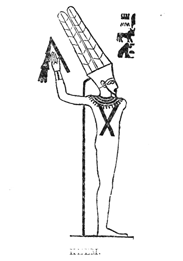
VI — Brief Summary: Feeble Dynasties — The Eleventh — The Twelfth, with its Mighty Kings.
Two royal lines, those of Mena and Pepi, had completed their career in Egypt. The seat of dominion, which had been at Abydos, had been transferred to the new city of Memphis, which had risen from the bed of the Nile. Monarchs great and powerful had succeeded to the quieter rule of the Hor-shesu, and there had been established other forms of government, culture and social life. Conjecture has been busy in efforts to determine whence these master-spirits came that created these new conditions, from what region they derived their skill, and the periods of time when all this was begun and brought to pass.
The reply so far has been little more than the echo of the questions.
The discoveries of Professors Flinders-Petrie, of M. Jacques de Morgan, the Director-General of French Exploration, of M. Amelineau and their fellow-laborers, are the latest contributions at hand. They are very interesting as tending to modify some of the opinions which had been entertained. They seem to demonstrate the African origin of the early Egyptian population, but likewise a probable racial affiliation of the ruling classes of Kushites of Ethiopians of Southern and Middle Asia.
Perhaps the disclosure least expected was the practice of cremation. At the death of any of the earlier kings, the body, together with his personal property, was placed on the pyre for incineration; and when this had been accomplished the bones and remains of the various articles were preserved in the vases in the tombs. This was a structure of sun-dried bricks.
Inside of these tombs were found implements of flint, vases of stone, both of alabaster and obsidian, figures of animals carved from ivory and rock crystal, together with ornaments, glass beads and bracelets, and pieces of burned cloth. Many of the vases were of material which was not to be obtained in Egypt, but had been brought from Asia. The style of art was primitive.
The tombs near Nagada, in the Thebaid, resembled those of Chaldaea. There were no metallic implements or ornaments to be found. At Abydos the case was different. M. Amelineau describes a tomb at that capital very similar in style to those of the older necropolis, with the remains of a terrace-like roof supported by wooden beams. The body of the king was in a central room of the structure, but the cremation had been so complete that only a few bones were left. He also found both implements made of stone, vases, and figures of animals cut from rock-crystal, together with large quantities of ornaments of bronze. The style of manufacture is like that employed in ancient Assyria.
It seems that in Egypt as in other Oriental countries the bodies of royal personages only were cremated. For others the common practice was interment. The king, being venerated as a divine being, the offspring and representative, or even the incarnation of the god Ra or Horos, he was supposed to rise from his ashes to a new life, like the Phoenix of Egyptian tradition.
The name was preserved by hieroglyphic engraving in a tablet of stone of square or circular form. M. Amelineau discovered also the tombs of the kings Den and Dja, and others belonging to the First Dynasty. He also found vases of offerings, and not only the "banner-names" inscribed on the cylinders, but the titles of "King of Upper and Lower Egypt, Lord of the Vulture and Sacred Serpent."
A more significant discovery, however, was made by M. de Morgan at Nagada in 1897. He found in the royal tomb the name of the king, "Aha," carved in hieroglyphic character. This is a demonstration of the proficiency of the Egyptian learning at that period and that they then employed that mode of writing. The cutting, however, exhibited indecision, as though the knowledge of it was but newly acquired. M. Amelineau supplemented this discovery by the finding among the seals on the vases of the tombs at Abydos, one that was marked by the cylinder of that monarch. The scarabaeus had not been adopted at that period as a device for seals.
The calcined fragments of the body were removed from Nagara to the Museum at Gizeh, together with other relics, including vases and the figure of a dog artistically carved in ivory. Besides these, there were also broken pieces of an ivory plaque, which when joined together, disclosed the "Ka-name," or mystic appellation of the astral or divine counterpart of the royal personage; and attached to it was likewise the name borne by King Aha during his lifetime: Mena!
Fixing the capital of a united Egypt at the new site of Memphis, he and his successors directed their efforts persistently to the consolidating of their dominions, the promoting of sacred learning and the development of useful industries. Important features were incorporated into the laws, religious rites and administration. King Bai-neter enacted that women likewise should inherit royal power; and Seneferu, who extended his dominion beyond Goshen and the Seth-roite nome to the peninsula of Sinai, made other changes of an important character. About this time the embalming of the dead and the erecting of pyramids for the reception of the royal coffins, appear to have come into practice. Khufu was distinguished beyond his predecessors or the kings that succeeded. He enlarged the scope of royal power, added to the rites of worship, and increased the territory of the country. The Great Pyramid was a temple as well as a Holy Sepulchre, and throughout the succeeding dynasties was provided with a college of priests and prophets for the celebration of religious offices and initiations. The divinities revered in Upper Egypt, Num, Isis and Osiris, were now recognized at the royal court, and the king prepared a sacred ritual for their worship. This was the Augustan age of archaic Egypt.
The Fifth Dynasty followed clearly in the path marked out by its predecessors, in the cultivating of knowledge, and the diligent observing of religious worship. But the ascendency of Memphis was now waning, and the influence of other regions was perceptibly increasing.
The Sixth Dynasty, as we have seen, was in important respects a new departure. The sovereigns of this line appear to have displayed a stronger disposition for foreign conquest. Pepi, the principal king, had numerous wars with the Semitic populations at the east of Egypt, and he is supposed to have carried his arms into Arabia and Nubia. Like Khufu, who was in a great degree his prototype, he was a builder. He founded a city in middle Egypt which was known by his own name, and he also rebuilt and enlarged the principal sanctuaries. Carrying out the plan of his famous predecessor, he erected a new temple at Dendera or Tentyris (Ten-ta-Ra.) to the great Goddess, Hathor, in which were halls for occult and initiatory rites, a planisphere, and typical representations of the birth of the Universe.
The three children of Pepi succeeded to the throne. With the last of these, the beautiful Queen Neitokris, the dynasty came to an end.
Egypt was now rent by internal dissensions. No one was able, for centuries, to wear the double crown and to wield the lotus as well as the papyrus scepter. The local sovereigns in the several districts were engaged increasingly in conflict. "All this," says Brugsch-Bey, "suggests the picture of a state split up into petty kingdoms, afflicted with civil wars and royal murders; and among its princes or rulers of nomes there arose no deliverer able with a bold arm to strike down the rebels and seize and hold with firm hand the fallen reins of the reunited monarchy."
Manetho has no record of names from the Seventh to the Eleventh Dynasty. He or some one in his name has left the following meagre record:
"Seventh Dynasty. — Seventy Memphite Kings who reigned seventy days (or, as has been corrected, five Kings who reigned twenty years and seventy days).
"Eighth Dynasty. — Twenty-seven Memphite Kings who reigned one hundred and twenty-six years.
"Ninth Dynasty. — Nineteen Herakleotic Kings who reigned four hundred years.
"Tenth Dynasty. — Nineteen Herakleotic Kings who reigned one hundred and eighty years.
"Eleventh Dynasty. — Sixteen Diaspolitic Kings who reigned forty-two years. After them Amenemes reigned sixteen years."
This enumeration is little less than a jumble. There is every likelihood that Memphis was the arena of bloody conflict and ceased to be a capital. The two Dynasties of Khien-su or Herakleopolis, it has been insisted, held only a local dominion, while other parts of the country had also kings of their own.
The Tablet of Abydos, which was compiled by Seti and his famous son, gives the official names of nineteen Kings who reigned over southern Egypt, during six hundred years of misrule. Eratosthenes names eight, and the Turin Papyrus, six.
Thebes or No-Amun now became the mistress of Egypt. Only there the semblance of order seems to have been steadily maintained. The first kings of the Eleventh Dynasty were monarchs of moderate pretensions, who left few memorials except tombs that were simple pyramids built of unburnt brick. Mr. Birch describes their names as being alternately Antef and Mentu-hetep, and considers it probable that they continued in a direct unbroken succession. The coffins of two of them have been found. They were made of single trees, and their mummies were enclosed in pasteboard envelopes.
The first of these was Antef or Anen-tef, "the great Father." He was descended from the southern line of Theban princes. His tomb was rifled by the Arabs in 1827, and contained the royal mummy, adorned with a golden diadem which bore the usual figure of the royal serpent. The simulacra of the wasp and branch attested the rank of the illustrious dead, and the escutcheon bore the name of "Antef."
This monarch had been embalmed and inhumed by his brother Anentef-ao, who also succeeded to the throne. The tomb of this king was found by Mariette-Bey. It was a brick pyramid with a single chamber, and contained a memorial stone bearing the date of the fiftieth year of his reign. He was addicted to hunting and was warmly attached to pet animals. His image was found in a standing posture, and at the feet were the figures of four dogs, each of a different breed, and wearing a collar on which his name was inscribed. The animals were called Beheka Mahet, Ab-akar, Pehet-Kamu and Tekal Uhat-Khempet.
The third sovereign bearing the name of Antef, Nantef or Anentef was designated Tosi-Meres by Eratosthenes, with the additional sentence: "who is the sun," or incarnation of Ra. After him was another called by way of distinction, Anentif-na, "The Greater Antef," and likewise Sethi-Neilos. He was renowned for having raised his country to a rank superior to the others. The Tablet of Karnak significantly points out as a change that after the Antef hyks or local rulers were four kings. In plainer words, Egypt had once more a united government — the Eleventh Dynasty.
The scepters which had departed from Memphis were now in the hands of the Kings of Thebes, the city of Noph-Amun.
The most imposing figure of the new line was Mentu-hetep, who bore also the official name of Neb-kha-Ra, or Ta-neb-Ra. He not only established a dynasty, but the rulers of the vivified Egypt of later centuries were his descendants and based their divine authority as kings on the fact. A record on a rock in the island of Konossa, not far from Pi-lakh or Philae commemorates this king as the conqueror of thirteen nations. He made his residence at the town of Kebta or Koptos in "The beautiful valley of Ham-mamat," and his name together with that of his mother, Ama, is found in an inscription there.
The god Khem, "The Lord of the inhabitants of the desert," was the tutelary of Koptos, and Mentu-hetep was diligent in his worship. At the same time he was by no means derelict in devotion to other divinities. It ought to be borne in mind, however, that the names and personifications of the gods had reference to prominent divine qualities rather than to distinct individuality. Khem personated Amun, "the unknown god," of Thebes, and Ra or Horos of Abydos. An Egyptian was nothing if not religious.

After the practice of former kings, Mentu-hetep, in the second year of his reign, set about the construction of his pyramid. It bore the name of Khu-setu, "the place of illumination." A memorial stone at Abydos commemorates the priest who officiated at the sacrifices for the dead which were offered to the deceased monarch at this shrine. This king is recorded as having reigned over fifty years.
Mr. Birch credits to "Mentu-hetep III." the inscription in relation to the transporting of stones for the royal sarcophagus from the mountain to the banks of the Nile. It bears date on the 15th day of the month Paophi, (1) in the second year of his reign. Three thousand men were required for the work, masons, sculptors and workmen of all classes. Amun-em-hat, the royal commissioner of public works, superintended the whole undertaking. "He sent me," the inscription reads, "because I am of his sacred family, to set up the monuments of this country. He selected me from his capital city, and chose me out of the number of his counsellors. His Holiness ordered me to go to the beautiful mountain with the soldiers and principal men of the whole country."
The way from Koptos to the mountains lay through the valley of Hamma-mat, and another inscription records that the king caused a deep well ten cubits in diameter to be sunk in the desert for the use of the workmen, and for the refreshment of pilgrims.
The origin of obelisks is now set to the credit of the Eleventh Dynasty. Near the grave of Queen Aah-hetep, the illustrious descendant of Mentu-hetep, in the necropolis of Thebes, two obelisks were dug up in broken pieces. They were put together by Mr. Villiers-Stuart, and each was found to bear the name of an Antef. One of them also bore the inscription: "Neb-kheper-Ra, perfect of God, made for himself splendid temples."
The artist of this monarch, Mer-ti-sen, achieved a reputation almost surpassing that of his royal master. He was the beginner of a line of architects who flourished till the latest times, and their works of skill made Egyptian art celebrated over the world. The Doric order, the canon of proportion, and imperishable coloring are among the achievements of this period.
The last king of this series, Sankh-ka-Ra, is enumerated in the Tablet of Abydos as the fifty-eighth. His reign is memorable for the voyage of Hannu to the "divine country of Punt." This region was regarded as the cradle of archaic Egypt. It is described as washed by the great sea, full of valleys and hills, abounding in ebony and other choice woods, in frankincense, balsam, precious metals and costly stones; and also in animals, such as giraffes, hunting leopards, panthers, dog-headed apes, and ring-tailed monkeys, and likewise birds of strange plumage.
Tradition depicted Punt as the original land of the gods. Amun was considered as the hyk or king, Hathor as the Queen, and Horos as the "Holy morning star." Bes, the Egyptian Pan or Dionysos, was regarded as the oldest form of Deity and was described as going forth thence all over the world. The divinities, it was believed, had migrated from that region to the valley of the Nile, and hence the country on the Red Sea was named Ta-neter, "the land of the gods."
Hannu set out from Koptos for the sea with a force of three thousand men, and before taking ship offered a great sacrifice of oxen, cows and goats. His voyage was very prosperous. "I brought back," says he, "all kinds of products which I had not met with in the parts of the Holy Land. And I came back by the road of Vak and Rohan, and brought with me precious stones for the statues of the temples. But such a thing had never taken place before, since there had been kings [in Egypt]: nor was the like ever done by any blood-relations who had been sent to those places since the time of the Sun-god Ra."
TWELFTH DYNASTY.
"After these kings," says Manetho, "Amenemes (Amun-em-ha) reigned sixteen years. The name of this king has a suggestive likeness to that of the famous minister of Mentu-hetep, and both Manetho and the Turin Papyrus include him in the same dynasty. His claim was evidently based upon marriage to a princess of that dynasty, and certainly he held the throne by a precarious tenure. He was twice dethroned, and his whole reign was disturbed by conspiracies. His instructions to his son and successor declare this. He was, nevertheless, an able sovereign and ruled the two realms of Egypt, from Elephantina to the lowlands of the North, with a justice and wisdom that were generally acknowledged. Having succeeded in establishing his power, he proceeded to deliver his subjects from the inroads of the negro tribes of Nubia. A rock by the road from Korusko to the seacoast commemorates this expedition by this inscription:
"In the twenty-ninth year [ninth?] of king Amunemha he came hither to smite the inhabitants of the land of Wawat." (2)
The Twelfth Dynasty has recorded in its monumental records an extraordinary zeal for religion and public improvement. Amunemha founded the temple of Amun at Thebes, which became afterward eminent as the royal sanctuary of Egypt. He also built temples at Memphis and other capital cities, and placed in them images exquisitely carved in stone.
Each royal dynasty had its own precinct for the dead. Amunemha followed the customs of the Memphite kings and set up his pyramid. It bore the name of Ka-nefer, "the beautiful high place." He commissioned Anentef, the high priest of Khern at Koptos, the royal residence, to superintend the work of preparing the sarcophagus. It was cut from the mountain of Eohanna, in the valley of Ham-mamat, and removed to the plain. It was the largest receptacle of the kind, and the usual assurance is given: "Never had the like been provided since the time of the god Ea."
During the last two years of his reign the king made his son, Osirtasen I., (3) his partner on the throne. This policy avoided a disputed succession, and as the prince had inherited the regal divine quality from his mother, it obviated any dispute in regard to his father's authority. Indeed, he was set apart to this kingly office from before his birth.
The record of Manetho is involved in some confusion; as we find this statement equivocally made that this king was murdered by his eunuchs.
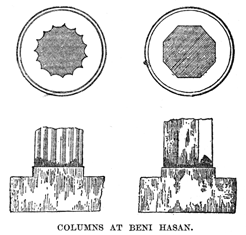
Osirtasen addressed his first efforts to the securing of the support of the priests. He proceeded to complete the public buildings at Thebes and other places which Amunemha had founded, and also built over the shrines at Heliopolis, (4) then the most revered of the holy places of Egypt. All through the coming centuries, the kings resorted to it year by year on pilgrimages. The two obelisks before its temple which commemorate this work were long regarded as the oldest of any in the country.
Under this king and his successors the arts and scientific knowledge acquired a perfectness which was not attained in former or later centuries. The grotto-tombs of this dynasty at Beni-Hassan are models of artistic skill, and their inscriptions and carvings glorify death itself, as a very conquest which life had made. Their fluted columns indicate to us the origin of the Doric order of architecture for which later Greece is famous, while the paintings and sculptures are a revelation of Egyptian life and history in an age of glory almost forgotten. (5)
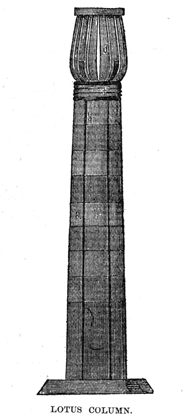
At Tanis there were also buildings and works of art of superior beauty and excellence. The picture of Osirtasen was often among them, and so it was elsewhere in upper and lower Egypt.
The king was also diligent in the details of administration. The tomb of Ameni at Beni-ITassan gives an elegant description of his government. This man was a Khar-tut (6) or warrior priest, and was hereditary prince of the nome of Mah or Antinoe, and child of the seers and prophets of the temple. He accompanied the king on military expeditions into Nubia, took charge of the booty and conveyed it to his royal master at Koptos. He "conquered" in the forty-third year of the king's reign, and the epitaph describes the character of his administration.
"I was a kind master," he declares of himself, "a ruler who loved his city. All the works of the palace of the king were placed in my hands. * * * * No child of the poor did I afflict; no widow did I oppress; no land-owner did I displace; from no five-hand master [small farmer] did I take away his men for my works. No one was unhappy in my time, no one was hungry in my time, not even in the years of famine. For I caused all the fields of the nome of Mah to be tilled. Thus I prolonged the life of its inhabitants and preserved the food that was produced. There was not a hungry man in the province. I distributed equally to the widow and to the unmarried woman; 1 gave no advantage to the great over the humble in all that I gave away."
Another official, Mentu-hetep, was the Ab, or confidential advisor to the king. His tombstone is now at the museum at Bulak, and his inscription describes him as "a man learned in the law, a legislator, one who apportioned the services, who regulated the works of the nome, who carried out the behests of the king, and who as judge gave decisions and restored to the owner his property. As the king's chief architect, he promoted the worship of the gods, and he instructed the inhabitants of the country according to the best of his knowledge, even as God [the King] commanded to be done. He protected the unfortunate and freed him who was in want of freedom.
"The great personages bowed down before him when he arrived at the outer door of the palace."
He superintended the building of the temple at Abydos and constructed a well, "according to the order of his Holiness, the Royal Lord." This well is described by Strabo, but has not been found.
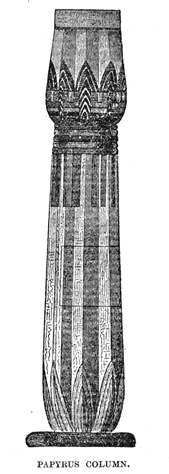
Another minister of great distinction was Nef-hetef, who also held office in the reign of his successor, Osirtasen II. He was of royal blood, and accordingly was made ruler in the city of Menat-Knufu, in the nineteenth year of the king's reign. His functions were largely religious. He provided for an abundant production of the necessaries of life, attended to the funeral services of the dead, sculptured descriptions of them for the "holy dwelling," and established there an officiating priest. He also ordered funeral offerings at all the feasts of the world below, — likewise offerings at the festivals of the new year, at the beginning of the great year, at the beginning of the year, at the end of the year, at the great feast of joy, at the feast of the summer solstice, at the feast of the winter solstice, at the festival of the five intercalary days, at the festival of She-tat, at the festival of the sand, at the twelve monthly feasts, and at the feasts on the plain and on the mountain.
Thus we observe that the king fixed the boundaries of the nomes or districts, confirmed the appointments of their hereditary princes as viceroys and directed the proper distribution of water for irrigation. The list of festivals further shows that the savants of the Nile were diligent in their studies and observations, knowing the stars and their positions in the sky, and the exact length to minutes of the year.
Manetho names this king Sesostris, and describes him as reigning forty-eight years, conquering all Asia Minor in nine years, and Europe as far as Thrace. He also represents him as setting up pillars in the different countries. Strabo also affirms that he conquered Ethiopia [Nubia] and the country of the Troglodytes and then crossed over into Arabia and overran all Asia. Apollonios the Rhodian also mentions these conquests. Aristotle and Dikearkhos also entertained the same opinion. Baron Bunsen also sustained this view, but considers Osirtasen III. as the actual Sesostris. "The Egyptians considered him to be first after Osiris." It is true that Thothmes III. and other kings of later periods honored Osirtasen as a god. But the more general belief, supported by evidence, indicates that Rameses II. was the king to whom this designation belongs.
The reign of Osirtasen II. is characterised in the painting at Beni-Hassan by the representation of a Semitic group of thirty-seven persons of the race called Mes-stem. They were from the "land of Abesha," and were received by the son of the prince, Nef-hetep. Their great eyes and aquiline noses indicated their origin. (7) Their wives and children had come with them. They were dressed in robes of many colors, and had brought as propitiary gifts a young gazelle and a quantity of al kohol suitable for painting the face. They were seeking a home in Egypt to escape famine. This was probably the beginning of the migrations which resulted finally in the subjugation of Egypt.
Osirtasen III. was superior to former kings in power and wisdom. He extended his conquests from Syene to the country beyond the second cataract and protected them from the incursions of the negro hordes by strong fortifications. He set up two pillars of stone with an image of himself at the landing, and inscribed on them a threat to disown the genuine descent of every son of his who did not maintain it. Egyptian temples were erected in the territory, and in later centuries Osirtasen was revered in Nubia as the guardian divinity along with god Neph or Totun.
Nevertheless Amunemha III. was more estimable for his achievements. He was distinguished by no extensive foreign conquests with their attendant massacres and atrocious cruelties, always characteristic of ancient and savage warfare, but by the nobler acts of benefaction to his people. He appears to have surpassed those who preceded him, in the extent of his scientific and geometric knowledge. Egypt is known to depend upon the annual inundations of the Nile for its very existence. These also took place in Nubia till the giving way of the chain of rocks at Silsilis about this time consigned that region to hopeless sterility. The famines which had prevailed in the previous reign and probably were now repeated turned the attention of the monarch from building to providing for the exigency.
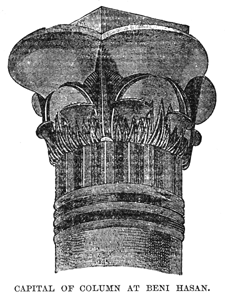
There was a natural basin in the Eayum, bounded on the two sides by the mountain. In the archaic period before Mena, artificial changes had been made in the channel of the river by princes of Abydos, that transformed the basin into a lake. The accumulation of mud brought thither by the river made the lake into a marsh. After a careful investigation of the topography of the country a canal was opened from the river to this marsh. (8) The gorges around were closed by dams, which thus converted it into an artificial reservoir, which received the water from the river at the inundations and retained it till the dry seasons, when it was let out to irrigate the fields.
Much curious speculation took place in regard to the personality of the monarch who accomplished this work. The lake was known by the Egyptian name of Mera, as was also the Labyrinth which stood a little distance away. Tradition becoming fixed in the form of history, designated a king Moeris as the founder. There were several kings in whose names the word "Mer" formed a part. Besides, there were many reasons for supposing Mena himself to have been the author. He had changed the course of the Nile to provide a site for his new metropolis. But the official designation of Amunemha III., Ka-en-ma, or Ma-en-Ra, was fixed upon as the origin of the name Moeris.
This was confirmed by the fact that he had constructed his sepulchre at the corner of the lake. The period of pyramid-building was passing away, and he ventured upon a wide innovation. Instead of placing the structure in the desert, he selected its site in the fertile home of Arsinoe, where he had transformed a pestilential swamp into a salubrious garden. It was a truncated pyramid-shaped pediment, which served as a base for both the colossal statue of the king and also of the queen, his consort or successor. Their names have been found on blocks of stone, resolving all doubts in the matter.
The Labyrinth has been justly termed one of the seven wonders of the world. Amunemha began the work of building when he began his reign, and in his ninth year he set about the procuring of material for this undertaking. Thousands of workmen were employed at the mines and quarries of the peninsula of Sinai and in the valley of Hammamat, and the king went personally in the ninth year of his reign to the valley of Rohan to give direction in regard to stones for statues.
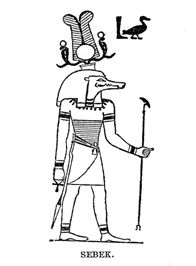
The Labyrinth is described by Herodotos as having three thousand chambers, half of them above and half of them below ground. The priests would not permit him to see the underground apartments, affirming that the kings and the sacred crocodiles were buried there. The upper rooms filled him with admiration. The paths across the courts, winding in every direction, the numerous structures, the walls covered with sculptures and paintings, the courts surrounded with colonnades built of white stone, exquisitely fitted together, excelled even imagination itself. At the corner stood a pyramid forty fathoms high, with figures engraved on it.
The monuments are significantly silent about this work. It is not very difficult now to guess the reason. The Arsenoite nome was hateful to the Egyptians of Abydos, Tentyris, and the country of Amun. Sebek, the Siva of Egypt, was the tutelary there, and the crocodile was his symbolic animal. Pi-Sebek, or Krokodilopolis, was the capitol of the nome, and abounded with temples founded by the kings of the Twelfth Dynasty, and obelisks of stone were erected to Sebek and his associate divinities. There was always a tame crocodile kept in the lake that visitors fed as a pet animal.
There were indications of a politic toleration on the part of the king. The title of the queen whose statue was placed on the pyramid with Amunemha was Sebek-nefru, and we find the same name borne by other ladies at this period. Amunemha IV. succeeded to the throne, but little of importance is known of his career. He simply followed the course of his distinguished father. He was succeeded by his sister, Sebek-nefer-ra, and with her the Twelfth Dynasty came to an end. The royal inheritance passed to a new family.
During the period of this dynasty the centre of gravity of the Egyptian state was situated in Middle Egypt. M. de Rouge remarks the progress made in art: "That long succession of generations which we are not able to determine precisely witnessed various and changing phases in the development of Egyptian art." He adds: "The origin of this Art is unknown to us; it begins with the remnants of the Fourth Dynasty. Architecture certainly shows an inconceivable perfection in regard to the working and building of blocks of great dimensions. The passages in the interior of the Great Pyramid remain a model that has never been surpassed." He remarks one form of ornament in the temples and tombs, two lotus-leaves placed opposite to each other. The human form is distinguished by some broad and thick-set proportions; but near the end of the Twelfth Dynasty the human figures became more slender and tall. The sculptures in relief are often of incredible delicacy. They were always painted over with colors. The engraving of the inscriptions on the monuments leaves nothing to be desired. The artist was the most honored man in the kingdom, standing near the monarch, who poured his favor in a full stream on the man of "enlightened spirit and a skillfully-working hand."
FOOTNOTES:
1. August-September. (return to text)
2. This country was in the gold-producing region now known as Ollaqui. (return to text)
3. Later Egyptologists spell this name with the initial letter U. The Egyptian priests also pronounced the name Osiris, with the upsilon. The hieroglyphic symbol is rendered indifferently a, e, or u. As the divinity Asari, Usari, or Hesiri, is best known by its Greek form, we have, though with misgiving, conformed to that orthography. (return to text)
4. Heliopolis was called Annu or An, as being "the city of obelisks." (return to text)
5. Ewald has translated the passage in the Book of Job (III., 14) very ingeniously as follows:
"Then should I have sunk in repose;
I should have found rest then in sleep;
With the kings and counsellors of the earth,
Who built themselves pyramids."
6. The "magicians" of the Pharaoh, mentioned in the book of the Exodus, are styled Khartummin in the Hebrew text. They were of sacerdotal rank, and often held official positions of a confidential character and important military commands. (return to text)
7. They were not Hebrews. The Jewish nose is "Roman" and not aquiline. (return to text)
8. Sir J. Gardner Wilkinson conjectures that the canal at this time extended from the higher land above Silsilis, in Nubia, conducting the water to Lake Moeris and also to the general tank system of Egypt, as the river offered a greater fall of water before the rocks gave way. (return to text)